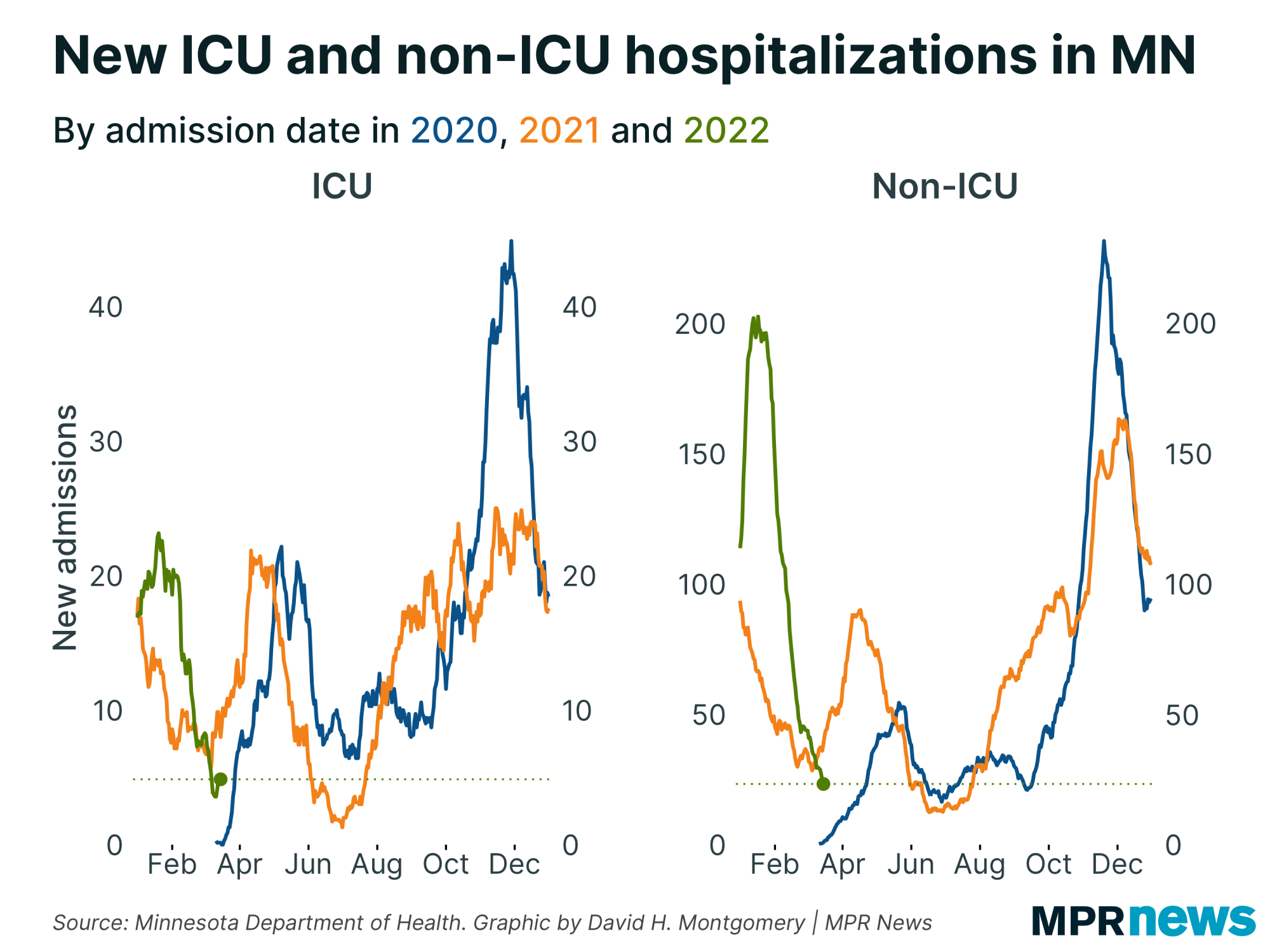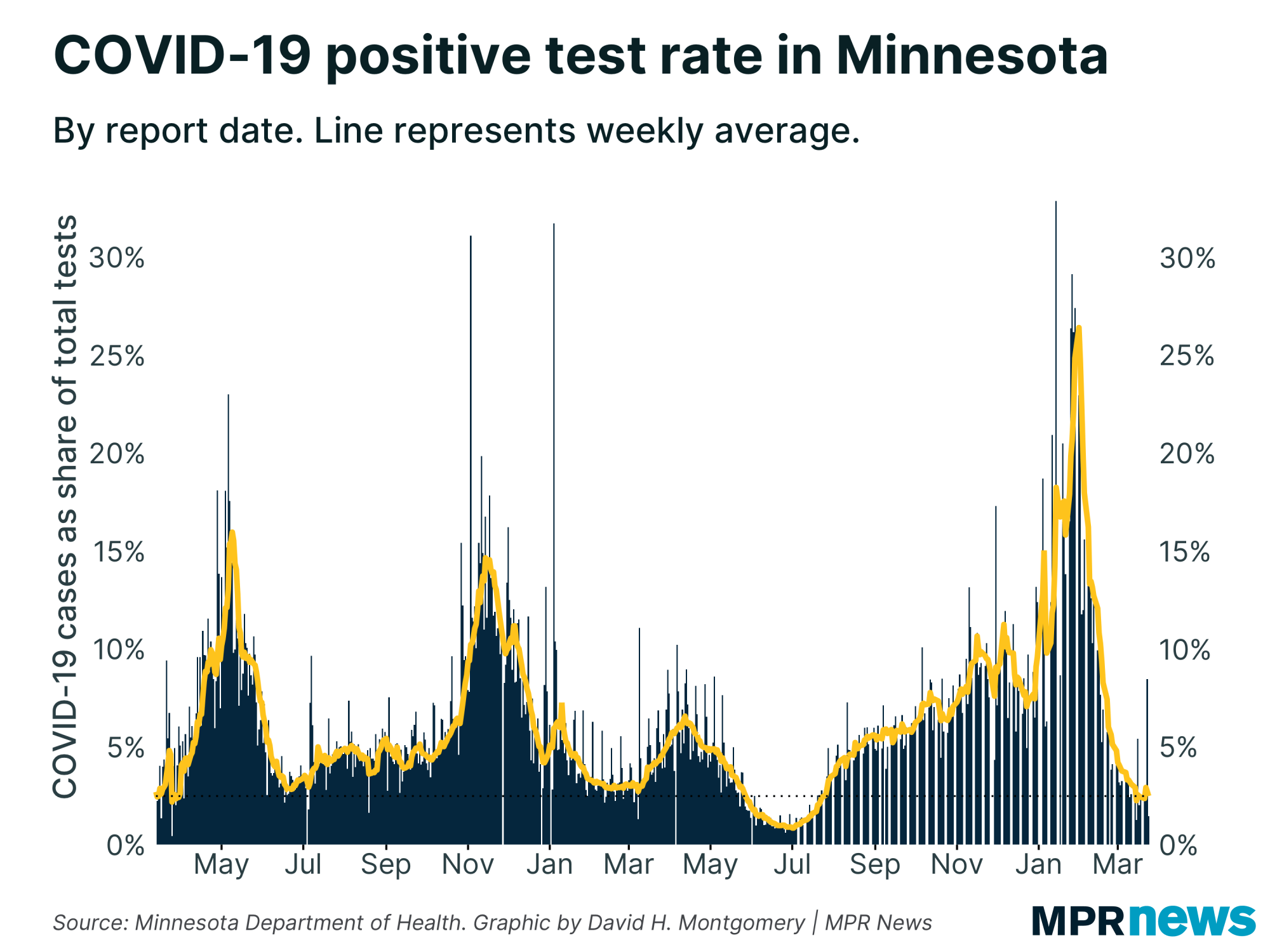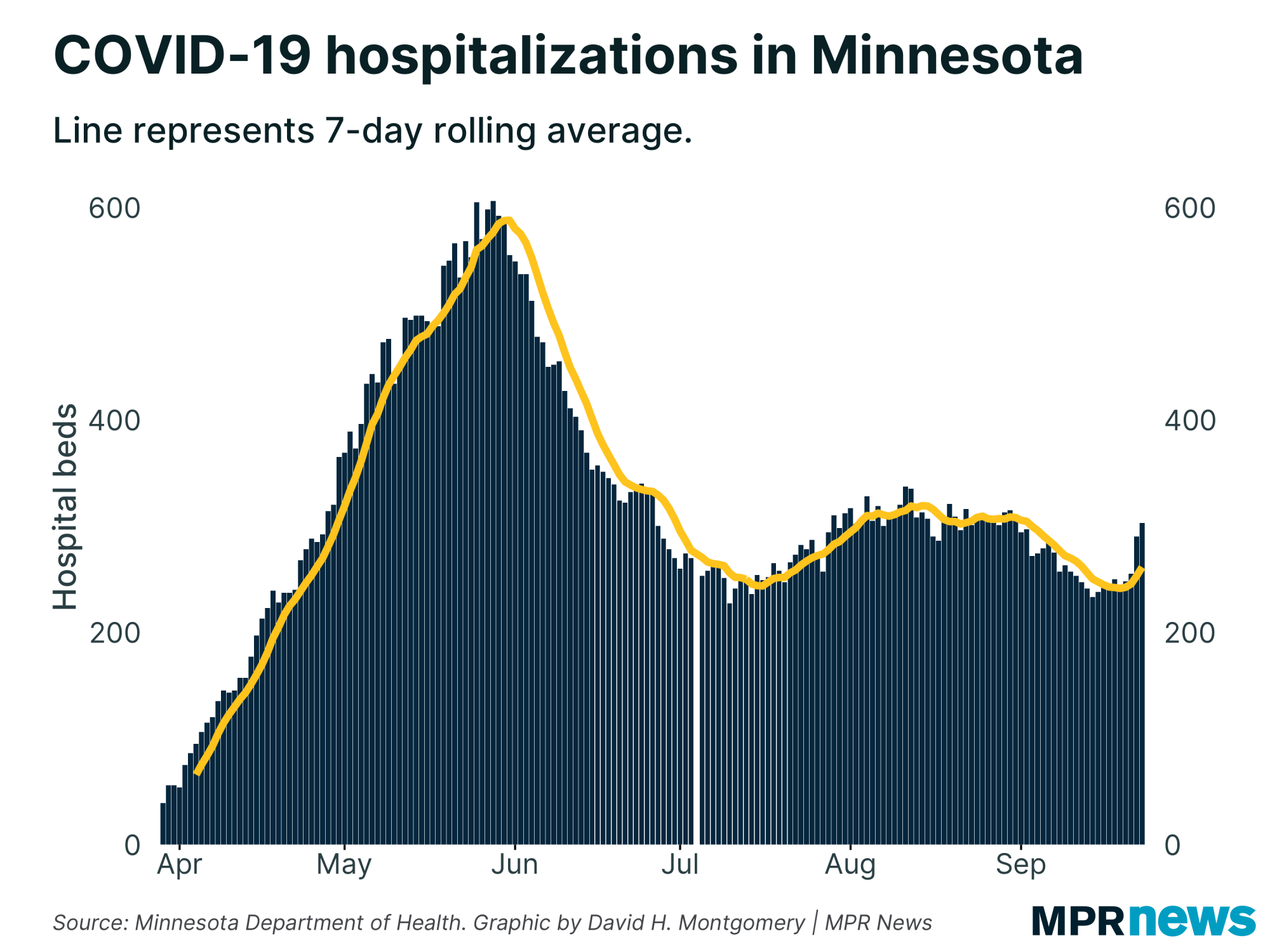Oct. 7 update on COVID-19 in MN: 14 more deaths; cases continue steep climb

Go Deeper.
Create an account or log in to save stories.
Like this?
Thanks for liking this story! We have added it to a list of your favorite stories.
Updated: 6:30 p.m.
Minnesota’s COVID-19 outbreak shows no signs of abating in new numbers released Wednesday, with 918 newly confirmed cases on relatively low testing. Fourteen more deaths pushed the state’s toll in the pandemic above 2,100.
The newest numbers follow seven consecutive days when average new daily case counts topped 1,000. The trend line of active COVID-19 cases in Minnesota remains at a record high in the pandemic.

Of the 106,651 cases of the disease confirmed in the pandemic to date, about 91 percent have recovered to the point they no longer need to be isolated.

Among the 2,101 who’ve died, about 71 percent had been living in long-term care or assisted living facilities; nearly all had underlying health problems.
Turn Up Your Support
MPR News helps you turn down the noise and build shared understanding. Turn up your support for this public resource and keep trusted journalism accessible to all.

On Wednesday, Gov. Tim Walz held a roundtable made up of Minnesotans who have been affected by COVID-19.
They included a man who was put into a medically-induced coma and a doctor who contracted COVID-19 early in the pandemic and now works with coronavirus patients.
Walz said while there is a lot of focus on numbers and statistics, each case or death is a person.
"A small percentage of people have yet been infected by COVID-19,” Walz said. “But the ripple effects through the community on each of these stories, shows you how devastating this can be if we don't get this right."
Kathryn Hall said her mother got COVID-19 while in a care facility. Hall’s mother soon entered hospice, where she died.
"Before my mother was sick, she described COVID as the invisible tiger and the difficulty being that you couldn't see it,” Hall said. “One of our challenges was deciding to go and be with my mom, and knowing what the risk was with that, and grateful that we were able to come through that safely. But these are horrendous choices that people are having to make."
Worries continue around college students, kids
People in their 20s make up the age bracket with the state’s largest number of confirmed cases — more than 24,500 since the pandemic began, including more than 14,200 among people ages 20-24.
The numbers help explain why experts remain particularly concerned about young adults as spreaders of the virus.

While less likely to feel the worst effects of the disease and end up hospitalized, experts worry youth and young adults will spread it to grandparents and other vulnerable populations and that spread could hamper attempts to reopen campuses completely to in-person teaching.
The number of high school-age children confirmed with the disease has also grown, with more than 10,000 total cases among children ages 15 to 19 since the pandemic began.
With many schools in Minnesota attempting to teach in-person, officials say they are especially concerned about the rising numbers of teens becoming infected and how that could affect decisions to keep school buildings open.

The Health Department last week identified seven school buildings in Minnesota with five or more confirmed cases of COVID-19 in students or staff who were in those buildings while infectious during a two-week reporting period.
The schools are: Brainerd High School, Albert Lea High School, Isanti Middle School; Fairmont Junior/Senior High School, Martin Luther High School and St. Paul Lutheran School in Martin County; and Hinckley Elementary School.
The fact that only seven schools have five or more such cases is “very positive,” Kris Ehresmann, the state’s infectious disease director, told reporters Friday. “We’re not seeing large outbreaks at all associated with a school setting.”

Ehresmann said that the agency had reports of 2,805 COVID-19 cases in the pandemic associated with colleges and universities with nine people needing to be in the hospital and three needing intensive care.
The numbers for colleges or K-12 schools don’t necessarily mean that the disease spread happened in school buildings, only that people were infectious while in a school building, she added.
Surges seen in northern, central Minnesota
Regionally, northern, southern and central Minnesota have driven much of the recent increase in new cases while Hennepin and Ramsey counties show some of the slowest case growth in the state.

Northern Minnesota, once by far the region least affected by the disease, has over the last week averaged the most cases per capita.
Collectively, rural areas of Minnesota continue to report the most new COVID-19 cases.
In southwestern Minnesota, at least 75 cases have been traced to a late-August wedding in Lyon County that officials have previously described as the state’s largest single social spreader event.
Thirty-nine cases have now been traced to a Martin County funeral, with one person hospitalized.

Southeastern Minnesota, specifically Winona, has been another hot spot as students return to college at Winona State and other schools. The problem has been compounded by similar outbreaks nearby across the Mississippi River at the University of Wisconsin-La Crosse.
Cases mushroom among Minnesota’s neighbors
Minnesota has seen its COVID-19 cases grow lately — but this real increase is small compared to other states in the Upper Midwest.
On Sept. 1, Minnesota was reporting around 140 new cases per million residents per day. This week, that figure is up around 185.
Wisconsin was seeing around 130 new cases per million residents per day on Sept. 1, similar to Minnesota. Today, that’s up to nearly 420 — more than three times higher.
Both North and South Dakota have similarly seen their cases per capita skyrocket far above Minnesota’s levels.

This is true even though Minnesota has higher testing rates for COVID-19 than every state in the region but North Dakota.
By positivity rate, which controls for testing volume, Minnesota has by far the lowest rate in the Upper Midwest, around 5 percent, versus more than 20 percent for Wisconsin and South Dakota.

Minnesota also has the lowest rates in the region for deaths and COVID-19 hospitalizations, controlling for population size.
Developments around the state
Walz set to renew COVID-related powers on Monday
A fifth special session for the year for the Minnesota Legislature has been set for Monday.
Gov. Tim Walz issued the proclamation Wednesday. He’s required by law to call the Legislature into session because he is extending a peacetime emergency related to the coronavirus.
The House and Senate have the power to overturn that authority but it would take majority votes in each chamber, which hasn’t happened to date due to divided party control.
The session will convene at noon on Monday. It’s unclear if other measures, such as a construction projects borrowing bill, will come up for votes.
— Brian Bakst | MPR News
Hospitalization data change draws questions
A recent change to the COVID-19 data reported by the Minnesota Department of Health is drawing fire from Republican lawmakers.
On Sept. 24, the Health Department’s daily COVID-19 update stopped reporting the number of Minnesotans currently hospitalized with the disease, and in intensive care units, which it had shared every day since early in the pandemic. Instead, it began reporting the number of new hospital and ICU admissions.
“In order to best understand the severity of disease, we want to look at the proportion of cases admitted to the hospital,” said Kris Ehresmann, the state’s infectious disease director, in a Sept. 23 briefing. “At this point in the pandemic, it makes the most sense to focus on this measure.”
Now 26 Republican members of the state Senate have sent a letter to Health Commissioner Jan Malcolm asking her to resume sharing data on current hospitalization rates.
“Legislators, health care leaders, citizens, businesses, the press and even hospital executives rely on these vital statistics to make crucial decisions,” wrote the letter’s principal author, Sen. Michelle Benson, R-Ham Lake.
Here’s how the hospitalizations data used to be reported daily:

Here’s how the Health Department reports it now:

The old stats on hospital occupancy captured several different aspects of COVID-19. When occupancy numbers went down, that could reflect a combination of fewer new admissions, more patients being discharged, and more patients dying. The new data only captures changes in admissions, and not how long patients are hospitalized.
In lieu of their daily hospitalization updates, health officials said they would include more detail on hospitalizations in their weekly updates, published every Thursday. Those data weren’t included in last week’s report as initially promised.
“We weren’t able to get it included [last] week as we had hoped, but we are still actively working on it,” said Health Department spokesperson Andrea Ahneman. “I know there’s great interest in the data.”
— David H. Montgomery | MPR News
Top Senate Republican tests negative after meeting with Trump in MN
Minnesota Senate Majority Leader Paul Gazelka plans a second COVID-19 test this week after one he took on Friday came back negative.
Gazelka was among the Minnesota Republicans who came in contact with President Donald Trump during his stop in the state last week prior to announcing he had the virus.
The top legislative Republicans says he’ll limit activities and get tested again for coronavirus later this week. He said he received his initial results Monday.
No Republicans who were part of the Trump campaign stop have said they are positive for COVID-19.
Republican U.S. Senate candidate Jason Lewis, who was also at a Minneapolis-St. Paul International Airport greeting event for Trump, said his test result for coronavirus came back negative. He said he would resume campaign events after four days of quarantine.
— Brian Bakst | MPR News
MDH hosting more free testing sites around Minnesota
The Minnesota Department of Health, in partnership with the Minnesota National Guard and local health officials, is offering another round of free COVID-19 testing sites in communities across the state.
"We are doing everything we can to expand access to all Minnesotans for COVID testing," said Dan Huff, assistant commissioner with the state Health Department.
"You don't need an ID," Huff said. "What you do need is a phone number or an email so we can get in touch with you with the results. If you are having any symptoms, definitely go get tested. If you have been identified as a contact of someone who is infected, go get tested. Or if you're anxious — go and get tested."
This week's test sites include:
Cloquet, Fond du Lac Tribal and Community College Gym — Wednesday and Thursday from noon to 6 p.m.
Fairmont, Armory — Wednesday and Thursday from noon to 6 p.m.
Inver Grove Heights, Armory — Wednesday and Thursday from noon to 7 p.m.
Minneapolis, New Salem Baptist Church — Thursday and Friday from 2-6 p.m.
Northfield, Emmaus Church — Wednesday and Thursday from noon to 6 p.m.
St. Joseph, Clemens Field House at College of Saint Benedict — Wednesday and Thursday from noon to 6 p.m.
Willmar, Armory — Wednesday and Thursday from noon to 6 p.m.
State health officials are encouraging people to sign up for an appointment in advance, to avoid long lines. Find more information here.
— MPR News Staff
Top headlines
Health officials tie northern Minn. COVID-19 surge to everyday gatherings: While the growth of new COVID-19 cases has leveled off in the Twin Cities metro area, it continues to surge in greater Minnesota, especially across the northern third of the state, which over the last week has averaged the most cases per capita.
Wisconsin governor restricts public indoor gatherings: Wisconsin has become one of the worst hot spots for the disease over the last month. The order limits public indoor gatherings to 25 percent of the room or building's capacity. Gatherings in indoor spaces without an occupancy limit will be limited to 10 people. The order does not apply to colleges, schools, churches, polling locations, political rallies and outdoor venues.
2 St. Paul hospitals to close, psychiatric beds reduced in Fairview's shakeup: Fairview Health is closing St. Joseph’s downtown along with Bethesda Hospital near the state Capitol. Fairview may phase out more than 100 inpatient psychiatric beds at St. Joseph’s and will eliminate the 18-bed unit at Fairview Southdale.
Teachers, parents, districts at odds over learning scenarios: Most Minnesota students are receiving remote instruction five days a week or are getting a mix of virtual and in-person learning. The lapse in child care support for families means many parents are pushing back and scrambling to figure out their own solutions. This has put them at odds with some educators who say they still don't feel safe returning to school buildings.
Minneapolis restaurant quarantines 13 who worked Trump event: The 13 work for Murray's Restaurant in downtown Minneapolis, which catered the fundraiser on Wednesday at the Lake Minnetonka home of Marty Davis, CEO of the quartz countertop manufacturer Cambria Co. LLC.
COVID-19 in Minnesota
Data in these graphs are based on the Minnesota Department of Health's cumulative totals released at 11 a.m. daily. You can find more detailed statistics on COVID-19 at the Health Department website.


